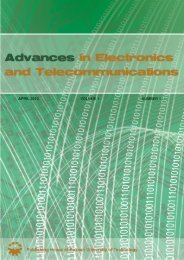november 2010 volume 1 number 2 - Advances in Electronics and ...
november 2010 volume 1 number 2 - Advances in Electronics and ...
november 2010 volume 1 number 2 - Advances in Electronics and ...
You also want an ePaper? Increase the reach of your titles
YUMPU automatically turns print PDFs into web optimized ePapers that Google loves.
12 ADVANCES IN ELECTRONICS AND TELECOMMUNICATIONS, VOL. 1, NO. 2, NOVEMBER <strong>2010</strong><br />
Diversity <strong>and</strong> Multiplex<strong>in</strong>g Techniques<br />
of 802.11n WLAN<br />
Abstract—This paper is devoted to analyze an improvement<br />
<strong>in</strong> the performance of WLAN (Wireless Local Area Network)<br />
systems <strong>in</strong>troduced by space <strong>and</strong> space-time diversity, as well<br />
as spatial multiplex<strong>in</strong>g. These MIMO (Multiple-Input Multiple-<br />
Output) techniques are approved <strong>in</strong> the latest 802.11n specification.<br />
In order to perform the experiment, a Matlab application<br />
that simulates WLAN physical layer has been developed.<br />
Index Terms—Signal process<strong>in</strong>g, MIMO systems, diversity<br />
schemes, cod<strong>in</strong>g, modulation.<br />
I. INTRODUCTION<br />
COMMON WLAN st<strong>and</strong>ards def<strong>in</strong>ed by IEEE operate <strong>in</strong><br />
the ISM (Industrial, Scientific, Medical) b<strong>and</strong>s, i.e. 2.4<br />
GHz <strong>and</strong> 5.2 GHz. OFDM (Orthogonal Frequency Division<br />
Multiplex<strong>in</strong>g) is applied to overcome <strong>in</strong>tersignal <strong>in</strong>terference<br />
(ISI). The transmission runs <strong>in</strong> a frame mode. Numerous<br />
Modulation <strong>and</strong> Cod<strong>in</strong>g Schemes (MCS) are provided, which<br />
are switched by the transmitter adaptively, accord<strong>in</strong>g to the<br />
channel condition.<br />
The new specification of WLAN systems [1] has <strong>in</strong>troduced<br />
many techniques to improve data rate <strong>in</strong> the physical layer.<br />
Apart from modification of the OFDM symbol (52 subcarriers<br />
dedicated for data transmission <strong>in</strong>stead of 48 <strong>in</strong> 802.11a/g,<br />
shorter guard <strong>in</strong>terval), two groups of methods can be dist<strong>in</strong>guished:<br />
with backward signal<strong>in</strong>g <strong>and</strong> without it. The first<br />
group comprises beamform<strong>in</strong>g, i.e. based on knowledge of<br />
the channel state, the transmitter forms the signals <strong>in</strong> such a<br />
way that their performance at the receiver’s <strong>in</strong>put is optimized.<br />
These methods are not considered <strong>in</strong> the paper, which focuses<br />
on the space <strong>and</strong> space-time diversity techniques, <strong>in</strong>stead.<br />
Spatial multiplex<strong>in</strong>g is also addressed.<br />
Some results of multi-antenna OFDM systems preformance<br />
have been delivered <strong>in</strong> a few articles, e.g. [2], [3]. They can be<br />
treated as a reference to the present work to verify the accuracy<br />
of the simulation Matlab code developed by the author.<br />
The article is organized as follows: Section 2 reviews space<br />
<strong>and</strong> space-time diversity techniques, while Section 3 refers to<br />
spatial multiplex<strong>in</strong>g. The simulation results are presented <strong>in</strong><br />
Section 4. F<strong>in</strong>ally, Section 5 concludes the work.<br />
II. SPACE AND SPACE-TIME DIVERSITY SCHEMES<br />
The aim of space <strong>and</strong> space-time diversity is to improve<br />
radio l<strong>in</strong>k quality, by means of MIMO technology. In the first<br />
M. Krasicki is with the Faculty of <strong>Electronics</strong> <strong>and</strong> Telecommunications,<br />
Pozna University of Technology, Poznan, Pol<strong>and</strong> (phone: +48 61 665 39 36;<br />
fax: +48 61 665 38 23; e-mail: mkrasic@et.put.poznan.pl).<br />
This work was supported by the Polish M<strong>in</strong>istry of Science <strong>and</strong> Higher<br />
Education under Grant PBZ-MNiSW-02/II/2007.<br />
Maciej Krasicki<br />
Fig. 1. Transmitter <strong>and</strong> receiver of system exploit<strong>in</strong>g space (space-time)<br />
diversity<br />
place, the systems with only receive diversity will be considered.<br />
Afterwards, a smart idea of Space-Time Block Cod<strong>in</strong>g<br />
(STBC) [4], which is proposed by 802.11n specification, will<br />
be exam<strong>in</strong>ed. A general model of the transmitter <strong>and</strong> the<br />
receiver of a system employ<strong>in</strong>g space (space-time) diversity<br />
is shown <strong>in</strong> Fig. 1. At the transmitter, adjacent data bits are<br />
encoded by a convolutional encoder. Consecutive codewords<br />
are distributed among adjacent subcarriers accord<strong>in</strong>g to the<br />
block <strong>in</strong>terleav<strong>in</strong>g rule, after which they are mapped onto<br />
signals Ck(p), where k is the <strong>number</strong> of subcarrier <strong>and</strong> p<br />
denotes the <strong>number</strong> of OFDM symbol.<br />
The STBC encoder (if implemented) takes the consecutive<br />
signals Ck(p) <strong>and</strong> Ck(p + 1), occupy<strong>in</strong>g a given subcarrier k,<br />
which fall to the p-th <strong>and</strong> the (p + 1)-th OFDM symbols, <strong>and</strong><br />
creates their modified copies. All the signals are transmitted<br />
accord<strong>in</strong>g to the orthogonal Alamouti scheme [4], i.e. the<br />
first antenna transmits Ck1(p) = Ck(p) <strong>and</strong> Ck1(p + 1) =<br />
−C∗ k (p + 1) on the p-th <strong>and</strong> the (p + 1)-th OFDM symbol,<br />
respectively. Simultaneously, the second antenna transmits<br />
Ck2(p) = Ck(p + 1) <strong>and</strong> Ck2(p + 1) = C∗ k (p). The signals to<br />
be transmitted via the second antenna are cyclically rotated,<br />
accord<strong>in</strong>g to 802.11n specification, but this operation does not<br />
result <strong>in</strong> further diversity ga<strong>in</strong>.<br />
If space-time diversity is not implemented, STBC block is<br />
“transparent”, i.e. Ck1(p) = Ck(p), Ck1(p + 1) = Ck(p + 1),<br />
etc. In this case only one stream is transmitted.<br />
Next, OFDM is performed by means of Inverse Fast Fourier<br />
Transformation (IFFT). F<strong>in</strong>ally, Cyclic Prefix is added to<br />
avoid <strong>in</strong>ter-signal <strong>in</strong>terference. In a real system Digital/Analog<br />
conversion <strong>and</strong> carrier modulation should be done before<br />
the signals are transmitted. These steps can be omitted <strong>in</strong><br />
simulations s<strong>in</strong>ce the transmission <strong>in</strong> a baseb<strong>and</strong> channel is<br />
considered.<br />
At the receiver, after Cyclic Prefix removal (CPR) <strong>and</strong>







